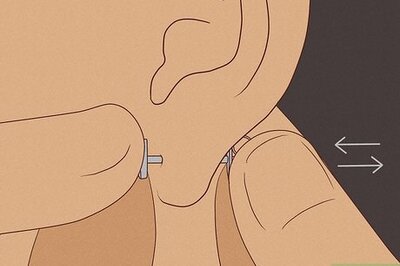
views
Green Ribbon for Mental Health Awareness
Mental health issues Green ribbons have come to symbolize mental health awareness worldwide. They can be worn in solidarity with mental health issues overall, or to support a particular cause; in this case, depression is the most common. It’s also possible to wear a green ribbon to show empathy for someone you know and love who is looking to improve their mental health issues. It’s hoped that wearing green ribbons for mental health can help remove some of the stigma associated with mental health and encourage open dialogue about it. Green ribbons are a visual symbol of growth, renewal, hope, and healing for those with mental health issues. Mental health awareness month takes place every year in May, when people are encouraged to display green ribbons more than in other months. The National Mental Health Association (NMHA), now known as Mental Health America (MHA), was formed in 1909; in the 1990s, it began using a green ribbon as a symbol for mental health awareness.
Bipolar disorder Green ribbons can be worn to draw attention to those with bipolar disorder. Like manic depression, bipolar disorder is associated with bouts of both mania and depression. Displaying the ribbon shows support for family members living with bipolar disorder and helps keep communication open about the condition. A light green ribbon is often used to bring awareness of bipolar disorder. In addition to a green ribbon, a black and white ribbon directly relates to the issue of bipolar disorder.
Childhood depression By wearing a green ribbon, it’s also possible to highlight the struggles of kids and families who directly deal with childhood depression. Green ribbons are a symbol for various mental health issues in children, including depression and mood disorders they’re facing. Wearing them shows support for children who are trying to overcome their issues to find growth and healing in the process. A light green or lime green ribbon is often worn on behalf of the childhood depression cause. Wearing a green ribbon is also linked to mental issues of retardation, manic depression, and Tourette's Syndrome, which is also represented by teal.
Green Ribbon for Health Conditions & Issues
Cerebral palsy A green ribbon signifies cerebral palsy awareness. Wearing or displaying the ribbon is a way to show your support for those with cerebral palsy and for better understanding the condition itself. The color is meant to inspire those with the condition to find growth, healing, and new beginnings. Individuals, affected families, and organizations like United Cerebral Palsy all use the green ribbon as a symbol of hope. Cerebral palsy awareness month is in March. Cerebral palsy is a neurological disorder that affects movement, posture, and muscle tone.
Mitochondrial disease Green ribbons are also a symbol of Mitochondrial disease awareness. Specifically, wearing a green ribbon for mitochondrial awareness also helps bring attention to the disease and focuses on research, treatment plans, and diagnosing the condition early. It also shows support for those with the condition and is focused on strength, courage, and hope. Companies doing research on behalf of mitochondrial disease treatment have been known to organize green ribbon campaigns for the cause of mitochondrial disease. Mitochondrial disease is a genetic disorder affecting mitochondria (powerhouse cells), which can lead to potential organ dysfunction or failure. Different shades of green are used for other congenital conditions like neural tube defects, fibrodysplasia ossificans progressiva, and spina bifida.
Traumatic Brain Injuries Wearing a green ribbon is a way to show solidarity for those experiencing traumatic brain injuries. Green ribbons symbolize hope for prevention and discoveries, along with support for individuals with intracranial injuries. Advocates display the ribbons to bring more awareness to TBIs overall.https://biausa.org/brain-injury/about-brain-injury/nbiic/what-is-the-awareness-ribbon-color-for-brain-injury Traumatic brain injuries involve trauma to the brain caused by an external force that, through impact, causes the brain to move or shift in the skull. Blue ribbons are more commonly worn to support brain injuries as a broader issue.
Organ donation & transplant Internationally, green ribbons represent all organ donors and transplants. The color green symbolizes the hopeful, life-giving act of both organ and tissue transplantation. In addition to showing support for organ and tissue donors, displaying green ribbons can broaden the conversation around the importance of becoming a registered organ and tissue donor. It is a symbol for creating a second chance at life for those in need of an organ or tissue transplant. The ribbon is also a reminder to discuss the wishes of family members in connection with organ and tissue transplants.
Kidney disease As with other health conditions, a green ribbon stands for kidney disease awareness. It specifically raises awareness for chronic kidney disease, kidney cancer, and acute kidney injury. Those who wear a green ribbon for kidney disease do so to support others who need a kidney or who are on dialysis. The cause of kidney disease links back to organ donor awareness, since kidney transplants are a huge part of the disease. March is kidney disease awareness month.
Eye-related issues Wearing a green ribbon more broadly represents awareness for several eye-related issues, like glaucoma and eye injury prevention. Glaucoma is a group of eye diseases that damage the optic nerve. The green ribbon focuses on early diagnosis and early treatment for this irreversible disease. January is National Glaucoma Awareness Month.
HIV/AIDS While a red ribbon is traditionally worn to symbolize HIV and AIDS awareness, a green ribbon has come to represent acceptance and care for those living with and affected by HIV/AIDS, along with their families and communities. Many wear both a red ribbon and a green ribbon to tie together research and treatment for HIV/AIDS, as well as social acceptance.
Green Ribbon for Environmental Concerns
Climate change Wearing a green ribbon in the context of environmental issues is used to spread awareness about climate change and global warming. The green ribbon stands as a promise to protect planet Earth from the damage caused by climate change and to promote sustainable practices. The color green represents the earth in terms of renewal and healing. Sustainable initiatives to reduce climate change include reducing carbon footprints by using public transportation and consuming less, in addition to supporting sustainable businesses. Climate change occurs when long-term shifts in weather patterns happen in a specific area or region.
Conservation Similarly, green ribbons can bring attention to combating deforestation, the clearing of trees and forest areas for industrial purposes. They are also used to show solidarity for protecting ecosystems, preserving natural resources, and promoting responsible forest management. Specific issues within deforestation include logging and land clearing without safeguards or regulations that protect against harmful consequences for environmental communities. Wearing a green ribbon can also highlight issues with pollution by encouraging more sustainable practices worldwide.
Natural disasters Green ribbons are often worn to show support for victims of natural disasters. The ribbons are often tied around trees at or near sites where a natural disaster has taken place, such as a flood, tornado, or hurricane. They’re worn to honor those who lost their lives in the disaster and help those affected by the disaster. Green ribbons became a symbol of the 2023 Osong Bus Flooding in Korea. They also appeared tied around trees after the 2025 Texas floods.
Green Ribbon Historical Meaning
Green ribbons were once associated with the 17th-century English Civil War. The sea-green ribbon specifically became a symbol relating to the ideas of the Levellers, a radical political movement of the time that fought for popular sovereignty. The ribbons were later linked to the Whigs, a faction that opposed the monarchy and pushed for greater parliamentary power. The name of the Levellers group was referred to as the Green Ribbon Club. The green ribbon was typically worn by these groups in their hats, along with sprigs of rosemary.
Other Meanings for a Green Ribbon
Green ribbons can signify a variety of causes worldwide. In addition to being associated with mental health issues and various health and environmental conditions, green ribbons are worn for other socio-political reasons, some linked to a specific event and others relating to a broader cause. Some examples of these other meanings for a green ribbon are ahead: Support for farm families, especially their mental health. Anti-war protests in Russia relating to the Russian invasion of Ukraine, which began in 2022. The 2005 London bombings, where 4 bombs were detonated in central London. Worker safety in the construction industry, along with the physical dangers associated with related fields. Domestic violence is represented by wearing both green and purple ribbons. They symbolize awareness and hope for the return of missing and exploited children.
Other Shades of Green Ribbons
Different shades of green ribbons can mean different things. While green ribbons are linked to broader issues like mental health awareness, certain health conditions, and the environment, a specific shade of green might focus more on one issue or concern, while another might mean something totally different. Here’s a basic breakdown of some of the main shades of green and their meanings and associations: Dark green: Depression or bipolar disorder Light green: Childhood depression, celiac disease, or STDs. Sea green: Kidney disease, stuttering, or other speech disorders. Lime green: Lyme disease, lymphoma, or muscular dystrophy. Jade green: Hepatitis B or liver cancer. Teal green: Sexual assault, ovarian cancer, or anxiety disorders. Mint green: Genetic disorders or Ivemark syndrome.
Meanings of Other Awareness Ribbons
Red Red ribbons are closely associated with AIDS and HIV awareness as a way to support friends with HIV or AIDS. It grew in popularity in the early 1990s among members of the New York artist community struggling with the disease. It’s also linked to heart issues, like heart disease and congenital heart failure, and is a symbol for burn victims and those with high blood pressure. More meanings relating to the red ribbon follow here: Stroke Tuberculosis Adult-Onset Still’s disease Congenital heart defects Congenital heart disease Congestive heart failure Heart disease Epidermolysis Bullosa Evans Syndrome Factor XI deficiency AIDS/HIV Hemophilia High blood pressure Burn victims Inhalant abuse Lymphoma Marfan Syndrome Reflex Sympathetic Dystrophy (RSD) Brain aneurysm Blood cancers and disorders Burn victims
Orange Orange ribbons are linked to awareness for multiple sclerosis, along with Attention Deficit Hyperactivity Disorder (ADHD) and human rights abuses. In addition, there are several other causes and/or conditions for which orange ribbons can be worn. They are listed ahead: Amplified Musculoskeletal Pain Syndrome (AMPS) Functional Neurological disorder (FND) Reflex Sympathetic Dystrophy (RSD) Complex Regional Pain Syndrome (CRPS) Multiple Sclerosis Attention Deficit Hyperactivity Disorder (ADHD) Spinal cancer Prader-Willi Syndrome Autoinflammatory disorders Sensory processing disorder Exposure to Agent Orange Self-injury Human rights abuses Hunger Malnutrition Motorcycle safety Cultural diversity
Yellow Yellow ribbons are linked to 2 major causes: suicide prevention and the support of U.S. troops and armed forces. They’re often worn to show support for U.S. troops who are particularly vulnerable to suicidal ideation. Yellow ribbons are often wrapped around trees as a symbol of hope that a soldier will come home to their family. Yellow ribbons symbolize the following issues: Bladder cancer Bone cancer Suicide prevention Support for U.S. troops and armed forces Carbon monoxide poisoning Craniofacial acceptance Endometriosis Microcephaly Obesity
Blue Blue ribbons are worn to bring attention to the issue of child abuse above all. They’re often displayed to show support to victims of child abuse and their families. As with other color ribbons, blue ribbons are also linked to many other conditions and causes, like the following: Alopecia Acute Respiratory Distress Syndrome Arthritis Colon cancer Cyclic Vomiting Syndrome Dystonia Erb’s Palsy Guillain-Barré Syndrome Huntington’s disease Restless Leg Syndrome Child abuse Human trafficking Foster care Anti-bullying (in the United Kingdom)
Teal Teal ribbons primarily bring attention to the issues of sexual assault and for survivors of sexual violence. They can also highlight certain forms of cancer in women, particularly ovarian and cervical cancer. Teal ribbons are associated with a number of additional causes, which are listed below: Polycystic Ovarian Syndrome Polycystic Kidney Disorder Gynecological cancer (ovarian or cervical) Progressive Supranuclear Palsy Congenital Diaphragmatic Hernias Ectodermal Dysplasia Fibular Hemimelia Fragile X Syndrome Martin-Bell Syndrome Sexual assault Survivors of sexual violence Tourette’s Syndrome Anxiety disorder Dissociative disorders Military sexual trauma Obsessive-compulsive disorder (OCD) Panic disorder Post-traumatic stress disorder (PTSD) Food allergies Knee injury
Purple Purple ribbons represent domestic violence awareness, animal abuse prevention, pancreatic cancer awareness, and addiction recovery. Other issues and conditions associated with purple ribbons are as follows: Lupus Alzheimer’s disease Testicular cancer Epilepsy Elder abuse Domestic abuse Animal abuse prevention Pancreatic cancer Addiction recovery Support for veterans and military children
Pink Pink ribbons are best known as symbols of breast cancer awareness. October is breast cancer awareness month, though pink ribbons are worn throughout the year, especially at special events and runs organized to donate money and resources to the cause. Other pink ribbon associations are here: Breast reconstruction Breast cancer Nursing mothers Birth parents
Gray Gray ribbons stand primarily for brain cancer awareness. They are traditionally worn every May to honor brain cancer awareness month, but can be worn any time for those who wish to. They’re also sometimes worn to show solidarity with those experiencing asthma, brain tumors, and diabetes, along with these conditions: Allergies Aphasia Asthma Diabetes Brain cancer awareness Brain tumors



















Comments
0 comment